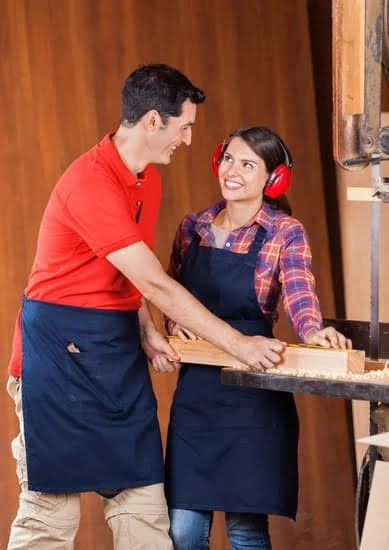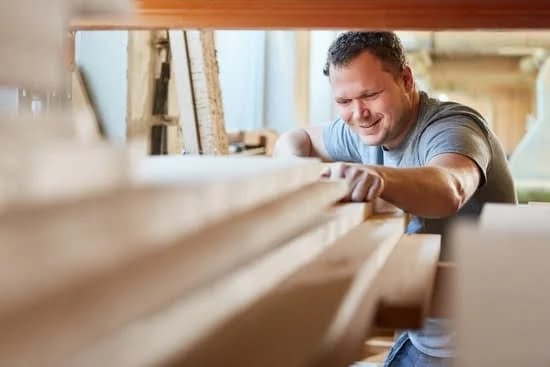Are you looking to add a touch of elegance to your woodworking projects? If so, learning how to make a beveled edge picture frame is the perfect way to achieve a stylish and professional finish.
Beveled edges can elevate a simple picture frame into a stunning piece of art, adding depth and visual interest. In this article, we will guide you through the process of creating your own beveled edge picture frame, from selecting the right materials to assembling and finishing the frame.
When it comes to woodworking projects, attention to detail makes all the difference in the final product. The beauty of a beveled edge picture frame lies in its clean lines and sophisticated look. By mastering the technique of creating beveled edges, you can enhance your woodworking skills and create frames that are not only functional but also visually striking.
In this comprehensive guide, we will cover everything you need to know about making a beveled edge picture frame. From selecting the right wood and materials to cutting precise beveled edges, assembling the frame, and adding the finishing touches, each step is carefully explained to help you achieve professional results. Whether you’re an experienced woodworker or new to the craft, this guide will provide you with valuable insights and practical tips for creating stunning beveled edge picture frames.
Materials Needed
When it comes to creating a beveled edge picture frame in woodworking, having the right materials and tools is essential for achieving professional results. To get started, there are several key items you will need to have on hand. First and foremost, you’ll need quality wood that is suitable for crafting picture frames.
Additionally, you’ll need a miter saw or table saw for cutting the beveled edges with precision. Clamps, wood glue, and finishing materials will also be necessary to assemble and finish the frame.
Finding high-quality woodworking materials is crucial for ensuring the success of your project. Look for reputable suppliers or stores that specialize in carrying a variety of wood types and finishes.
Online retailers may also offer a wide selection of woodworking materials, making it convenient to purchase everything you need in one place. Whether you choose hardwoods like oak or maple, or opt for softer woods such as pine or cedar, selecting top-notch materials will ultimately determine the overall look and durability of your beveled edge picture frame.
Investing in the right tools is equally important when it comes to making a beveled edge picture frame in woodworking. Along with a reliable miter saw or table saw, having clamps to hold pieces in place during assembly and wood glue for secure bonding are essential.
Additionally, don’t forget about sandpaper or sanding blocks for smoothing out rough edges and achieving a polished finish. By gathering all the necessary materials and tools upfront, you’ll set yourself up for a successful woodworking project and a stunning finished product.
Selecting the Wood
When it comes to making a beveled edge picture frame in woodworking, one of the most crucial steps is selecting the right type of wood for the project. The choice of wood plays a significant role in determining the overall quality and appearance of the finished frame. Here are some tips for selecting the perfect wood for your beveled edge picture frame:
- Consider the Wood Species: Different wood species offer varying grain patterns, colors, and durability. Popular choices for picture frames include oak, walnut, cherry, maple, and pine. Research each species to determine which one best suits your preferences for appearance and workability.
- Evaluate Wood Grain: Pay attention to the grain pattern of the wood as it can greatly impact the final look of the beveled edge picture frame. Select boards with visually appealing grain patterns that will complement the overall design of your frame.
- Quality and Durability: Opt for high-quality wood that is strong and durable to ensure that your beveled edge picture frame will last for years to come. Avoid using softwoods or low-grade lumber that may result in an inferior finish.
Once you have chosen the right type of wood with an attractive grain pattern and suitable durability, you can move on to preparing and cutting it to create stunning beveled edges for your picture frame project. By carefully considering these factors when selecting wood for your project, you can achieve a professional-looking finish that highlights the beauty of the beveled edges while showcasing your woodworking skills.
Cutting the Beveled Edges
Creating a beveled edge picture frame in woodworking requires precise cutting and shaping to achieve the desired look. Beveled edges add a touch of elegance and sophistication to the frame, making it stand out from traditional straight-edged frames. In this section, we will discuss how to accurately cut and shape the beveled edges using woodworking tools, as well as safety precautions and best practices for achieving precise beveled edges.
To begin cutting the beveled edges, you will need to use a miter saw or table saw with a beveling function. Measure and mark the angles for the beveled edges on each piece of wood that will make up the frame. It is crucial to double-check your measurements before making any cuts to ensure accuracy. Adjust the saw blade to match the angle of the bevel, and securely clamp the wood in place before cutting.
When using power tools for cutting the beveled edges, always wear appropriate safety gear such as safety glasses and hearing protection. Follow all safety guidelines provided by the manufacturer for operating power tools, including keeping hands and fingers away from the path of the saw blade. Take your time with each cut to ensure precision and avoid any accidents.
For hand tools such as hand planes or chisels, take care in maintaining sharp blades for clean and smooth cuts. Use a combination square or protractor to verify that your angles are accurate before proceeding with shaping the beveled edges. By taking these precautions and using proper techniques, you can achieve beautifully crafted beveled edges for your picture frame woodworking project.
Assembling the Frame
Once you have successfully cut and shaped the beveled edges of your picture frame, it is time to assemble all the pieces together. This step is crucial in ensuring that the frame is sturdy, well-constructed, and ready to showcase your favorite memories or artwork.
Detailed Assembly Instructions
Begin by laying out all the pieces of the frame to ensure they are in the correct position. Use clamps to hold the pieces together while you work on joining them. It’s important to follow a precise sequence when assembling the frame to avoid any errors or misalignments.
Secure the corners of the frame using wood glue before driving in finishing nails or screws. This will help reinforce the joints and create a strong bond between the wood pieces. Be sure to wipe off any excess glue as you go along to avoid dried-up residue on your finished frame.
After securing all corners, check for any unevenness or gaps in the joints. If needed, use a chisel or sandpaper to make adjustments for a seamless fit. Once you are satisfied with how everything looks and fits together, allow the glue to dry completely before moving on to the next steps.
Tips for Sturdiness
To ensure that your assembled frame is robust and durable, consider adding wooden splines across each corner joint. These splines can provide additional reinforcement and stability, especially if you plan on creating larger or heavier frames.
It’s also important to double-check each corner for squareness as you assemble the frame. Using a carpenter’s square can help you confirm that all angles are perfectly at 90 degrees, resulting in a well-constructed and professional-looking picture frame.
By following these detailed assembly instructions and tips for sturdiness, you can confidently proceed with creating a beveled edge picture frame that not only looks stylish but also stands the test of time.
Sanding and Finishing
After successfully cutting and assembling the beveled edges of your picture frame, the next step in creating a professional-looking finished product is sanding and finishing. Sanding not only smoothens the frame’s surface but also prepares it for staining, painting, or sealing to enhance its visual appeal. In this section, we will discuss techniques for achieving a smooth finish and various options for adding that final touch to your beveled edge picture frame.
Before applying any finish to your picture frame, it is crucial to ensure that the surface is free from any rough patches or imperfections. Start by using fine-grit sandpaper to gently sand the entire surface of the frame in the direction of the wood grain. Be sure to pay attention to any sharp edges or corners created by the beveled edges, as these areas may require extra care to achieve a consistent smoothness throughout the frame.
Once you have achieved a smooth and even surface on your picture frame, it’s time to consider how you want to enhance its appearance. Staining the wood can bring out its natural beauty and add depth to the color, while painting allows for endless creativity in customizing the frame’s look.
Alternatively, sealing the wood with a clear coat can protect it from wear and tear while maintaining its original appearance. Consider experimenting with different finishes on scrap pieces of wood before making a decision on which option best complements your beveled edge picture frame.
In addition, if you prefer a more rustic or weathered look for your picture frame, distressing techniques such as sanding certain areas more heavily can add character and charm to the finished product. Whichever finish you choose, always remember to follow all safety precautions when working with paints, stains, or sealants in a well-ventilated area.
With careful attention to detail during sanding and finishing, you can create an eye-catching beveled edge picture frame that perfectly showcases your woodworking skills.
Mounting the Picture
After successfully assembling your beveled edge picture frame, the next step is to securely mount the picture within the frame. The keyword “how to make a beveled edge picture frame woodworking” must be kept in mind during this process as it requires precision and attention to detail. Depending on the size and weight of the picture, different mounting techniques may be necessary.
For smaller, lightweight pictures, using wire or sawtooth hangers on the back of the frame can provide an easy and secure way to hang the frame on a wall. This method also allows for some flexibility in adjusting the positioning of the frame once it is mounted. For larger or heavier pictures, D-rings or keyhole hangers may be more suitable for providing additional support and stability.
After deciding on the appropriate hanging hardware, carefully measure and mark where these will be attached to the back of the frame, ensuring they are level and evenly spaced. Using a drill and screws, fasten the hangers securely to prevent any accidents while hanging your newly assembled picture frame.
Lastly, it’s important to test different hanging methods to determine which one works best for your specific project. Regardless of which method you choose, always make sure that your beveled edge picture frame is mounted securely before displaying it in your desired location.
| Step | Description |
|---|---|
| 1 | Attach wire or hangers to back of frame |
| 2 | Measure and mark placement for hanging hardware |
| 3 | Fasten hardware securely with screws |
Final Touches and Maintenance
After completing the process of making a beveled edge picture frame through woodworking, there are some final touches and maintenance tips to consider. Adding any final decorative touches or enhancements to the frame can further enhance its visual appeal and make it truly unique.
Whether it’s adding a personalized engraving, embellishments, or other decorative elements, these final touches can make the frame stand out even more. Additionally, applying a protective finish such as varnish or lacquer can help preserve the wood and provide long-term durability.
Once the beveled edge picture frame is complete, it’s important to understand how to care for and maintain its longevity. Regular dusting with a soft cloth or brush can help keep the frame clean and free from debris.
If the frame is stained or painted, avoid using harsh chemicals or abrasive cleaners that could damage the finish. When handling and displaying the framed picture, be mindful of placement to avoid exposure to direct sunlight or extreme temperature changes that could affect the wood over time.
Taking the time to add those final decorative touches and following proper maintenance practices for the beveled edge picture frame will ensure that it remains a beautiful and cherished piece for years to come. Whether it’s displayed in a home, office, or given as a thoughtful gift, a well-crafted beveled edge picture frame made through woodworking is sure to leave a lasting impression.
Conclusion
Creating a beveled edge picture frame in woodworking can add a touch of elegance and sophistication to any piece of art or photograph. By following the step-by-step guide outlined in this article, you can create a stunning and professional-looking picture frame that will beautifully showcase your treasured memories. Whether you are a beginner or an experienced woodworker, the process of making a beveled edge picture frame is both rewarding and enjoyable.
Tips for Success
To achieve the perfect beveled edge picture frame, it is crucial to pay attention to the details. Ensure that you have chosen the right type of wood with a beautiful grain pattern and high quality. Remember to take your time when cutting and shaping the beveled edges, as precision is key in creating a seamless and polished finish. When assembling the frame, make sure each joint is secure and accurately aligned to guarantee sturdiness.
Caring for Your Masterpiece
Once your beveled edge picture frame is complete, it’s important to properly maintain it in order to preserve its beauty for years to come. Regular dusting and cleaning will prevent buildup of dirt and grime, while periodic inspection for loose joints or weak spots will ensure the longevity of your masterpiece.
Consider placing the framed picture away from direct sunlight and extreme humidity to prevent damage over time. With proper care, your beveled edge picture frame will continue to showcase your cherished memories in all their glory.
As you venture into the world of woodworking, creating a beveled edge picture frame can serve as an excellent starting point for honing your skills. The satisfaction of crafting something truly unique with your own hands is incomparable, and as you experiment with different woods, finishes, and designs, you’ll find yourself inspired and motivated to explore further creative possibilities within the realm of woodworking.
So don’t hesitate – grab your tools, select some quality materials, and embark on this woodworking journey today.
Additional Resources and Inspiration
In conclusion, making a beveled edge picture frame through woodworking can be a rewarding and creative endeavor. The unique touch that beveled edges add to a picture frame can truly elevate the overall look and appeal of the finished product. By carefully selecting high-quality materials, paying attention to detail during the cutting and assembling process, and applying finishing touches with care, woodworkers can create stunning frames that showcase their craftsmanship.
It is important to remember that choosing the right type of wood is crucial for achieving professional-looking results. The grain and quality of the wood will greatly impact the final appearance of the frame. Additionally, taking safety precautions and following best practices when cutting and shaping beveled edges is essential for achieving precise and accurate results.
As enthusiasts continue to explore their woodworking skills, they are encouraged to seek additional inspiration from resources such as tutorials or other woodworking projects that feature beveled edges. Experimenting with different types of finishes, stains, or paints can also add a personal touch to the frames. Ultimately, by maintaining care for their handmade creations, woodworkers can enjoy displaying their beveled edge picture frames with pride for years to come.
Why not give it a try? Making your own beveled edge picture frame through woodworking could provide a wonderful opportunity for creativity and self-expression in your craft.
Frequently Asked Questions
How Do You Cut a Bevel for a Frame?
To cut a bevel for a frame, you will need a miter saw or a table saw with a bevel cutting function. Start by measuring the dimensions of the frame and then set your saw to the appropriate angle for the bevel cut.
Place the frame molding against the saw fence and carefully make the cut. It’s important to ensure that the angle is precise to achieve a clean and professional-looking bevel.
How Do You Cut Angles for a Frame?
Cutting angles for a frame requires careful measurement and precision cutting. Most frames have 45-degree angles at each corner, but it’s essential to measure and double-check before making any cuts. Use a miter saw or miter box to make straight and accurate cuts at the specified angles ensuring that they fit together perfectly when assembled.
What Is a Bevel Picture Frame?
A bevel picture frame is a type of frame where the edges are cut at an angle, typically 45 degrees, creating an edge that is not perpendicular to the front face of the frame. This design can add depth and visual interest to the frame, especially when used with artwork or photographs.
Bevel frames are commonly used for showcasing special or decorative pieces due to their elegant and sophisticated look.

Hi everyone! I’m a woodworker and blogger, and this is my woodworking blog. In my blog, I share tips and tricks for woodworkers of all skill levels, as well as project ideas that you can try yourself.





